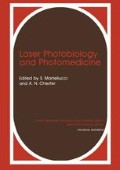Abstract
Lasers used for surgery and for some other biomedical applications can pose potential hazards to both the patient and the laser operating personnel. Because the laser beam is normally in the open when emitted from a surgical laser, special precautions are necessary. Unlike many industrial application of lasers, the very nature of most laser surgical procedures require both a flexible and often an open beam and the use of administrative controls with protective eyewear rather than engineering controls such as beam enclosures, baffles, etc. The potential for hazardous exposure to laser radiation can therefore be quite high for some surgical personnel[1,2,3].
Access this chapter
Tax calculation will be finalised at checkout
Purchases are for personal use only
Preview
Unable to display preview. Download preview PDF.
References
D. H. Sliney and M. L. Wolbarsht, 1980, “Safety with Lasers and Other Optical Sources,” Plenum Publishing Corp., New York.
D. H. Sliney, 1981, Laser Safety, in: “New Developments of Lasers,” L. Goldman, ed., Springer-Verlag.
L. Goldman and R. J. Rockwell, 1971, “Lasers in Medicine,” Gordon and Breach, New York.
World Health Organization, 1982, “Environmental Health Criteria Document No. 23, Lasers and Optical Radiation,” World Health Organization, Geneva.
International Electrotechnical Commission (IEC), 1983, “Radiation Safety of Laser Products Equipment Classification, Requirements and Users Guide, Document TC76,” IEC, Geneva.
C. Gulacsik, D. C. Auth, and F. E. Silverstein, 1979, Appl.Opt., 18(11):1816–1823.
D. L. Jenkins, 1979, “Non-ionizing Radiation Protection Special Study No. 25-42-0310-79, Hazard Evaluation of the Coherent Model 900 Photocoagulator Laser System, Jan-Feb, US Army Environmental Hygiene Agency, Aberdeen Proving Ground, MD (NTIS No. ADA068713).
K.W. Marich, J.B. Orenberg, W.J. Treytl, and D. Glick, 1972, Am.Ind.Hyg.Assn.J., 33(7):488–491.
J. C. Snow, B. J. Kripke, M. S. Strong, G. J. Jako, M. R. Meyer, and C. W. Vaughan, 1974, Anesth.Analg., 53: 507–512.
Author information
Authors and Affiliations
Editor information
Editors and Affiliations
Rights and permissions
Copyright information
© 1985 Plenum Press, New York
About this chapter
Cite this chapter
Sliney, D.H. (1985). Laser Safety in Laser Surgery. In: Martellucci, S., Chester, A.N. (eds) Laser Photobiology and Photomedicine. Ettore Majorana International Science Series, vol 22. Springer, Boston, MA. https://doi.org/10.1007/978-1-4613-2461-4_22
Download citation
DOI: https://doi.org/10.1007/978-1-4613-2461-4_22
Publisher Name: Springer, Boston, MA
Print ISBN: 978-1-4612-9494-8
Online ISBN: 978-1-4613-2461-4
eBook Packages: Springer Book Archive

